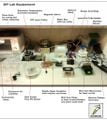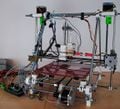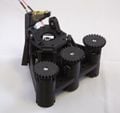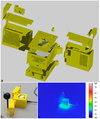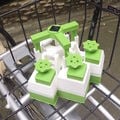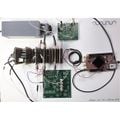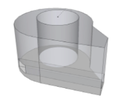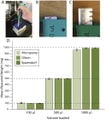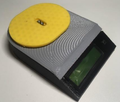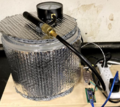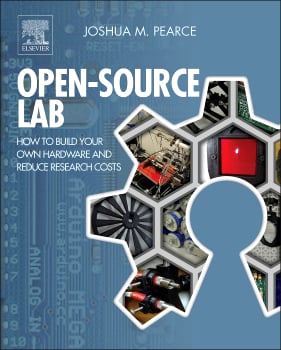
Laboratório de código aberto, 1ª edição: como construir seu próprio hardware e reduzir custos de pesquisa
- escrito pelo usuário da Appropedia JM Pearce
- JM Pearce, Laboratório de código aberto: como construir seu próprio hardware e reduzir custos de pesquisa , Elsevier, 2013.
- ISBN: 9780124104624
- http://store.elsevier.com/Open-Source-Lab/Joshua-Pearce/isbn-9780124104624/
- Entrevista sobre equipamento de laboratório de código aberto de 2016 na Rádio Nova Zelândia - Ogg , MP3
- A Elsevier disponibilizou gratuitamente este capítulo por um ano, até 20 de novembro de 2020: Laboratório de código aberto: como construir seu próprio hardware e reduzir custos de pesquisa .
Conteúdo
Conteúdo grátis
Este guia detalha o desenvolvimento da revolução do hardware gratuito e de código aberto e fornece instruções passo a passo sobre como construir seu próprio hardware de laboratório.
Nos dois primeiros capítulos apresentados aqui, o autor define os termos básicos do software de código aberto e discute a ascensão da revolução do hardware de código aberto e como ela impacta a ciência antes de explorar cinco vantagens pragmáticas de ingressar na comunidade científica de código aberto para ambos. sua pesquisa em geral e, o mais importante, seus equipamentos e instrumentação.
Características principais
- Numerosos exemplos de tecnologias e comunidades de usuários e desenvolvedores de código aberto que as apoiam
- Instruções sobre como aproveitar as vantagens do compartilhamento de design digital
- Explicações de Arduinos e RepRaps para uso científico
- Um guia detalhado para licenças de hardware de código aberto e princípios básicos de propriedade intelectual
Descrição
Laboratório de código aberto: como construir seu próprio hardware e reduzir custos de pesquisa científica detalha o desenvolvimento da revolução do hardware gratuito e de código aberto . A combinação de impressão 3D de código aberto e microcontroladores de código aberto executados em software livre permite que cientistas, engenheiros e pessoal de laboratório em todas as disciplinas desenvolvam ferramentas de pesquisa poderosas a custos baixos sem precedentes.
Depois de ler o Open-Source Lab, você será capaz de:
- Reduza os custos de equipamento fabricando seu próprio hardware
- Crie hardware de código aberto para pesquisa científica
- Participar ativamente de uma comunidade na qual os resultados científicos são mais facilmente replicados e citados
Exemplos
Veja também a galeria gráfica abstrata do HardwareX
Hardware científico de código aberto é hardware de código aberto usado por cientistas para fazer pesquisas ou para educação. Esta galeria e subpáginas associadas são uma extensão do livro Open Source Lab , que trata de como fazer equipamentos científicos seguindo princípios de código aberto .
O laboratório de código aberto: como construir seu próprio hardware e reduzir custos de pesquisa
NIH 3D Print Exchange - Labware personalizado imprimível em 3D
Equipamento científico imprimível em 3D - imprima seu laboratório em 3D
Equipamento científico imprimível em 3D, página 2 - mais impressões 3D para o seu laboratório
Equipamento científico imprimível em 3D, página 3 - e ainda mais
Biblioteca óptica de código aberto - e seu laboratório óptico
Bomba de seringa de código aberto - Biblioteca paramétrica de bombas de seringa de código aberto controladas pela web
GaudiLabs - Swiss Fab Lab fabricando instrumentos de laboratório de baixo custo
OpenTrons - Manipulação de fluidos de código aberto
Plasmatron - derivado de OpenTrons para cultura semiautomática de parasitas da malária
IOrodeo - empresa que fabrica instrumentos científicos de código aberto
Cambridge JIC - microscópio digital programável para impressão em 3D
Imagem de código aberto , RMN, ressonância magnética, EMF
Open Behavior FOSH para comportamento e cognição animal
Laboratório de detecção ambiental publicado abertamente na OSU - captação de chuva, cata-vento, umidade do solo, etc.
Arduino - uma classe de microcontroladores de código aberto úteis para automatizar equipamentos
Raspberry Pi - computador do tamanho de um cartão de crédito rodando Linux
Red Pitaya - ferramenta de medição e controle de código aberto
OpenLabTools - iniciativa da Universidade de Cambridge em hardware de código aberto para ciência
Tekla Lab - iniciativa da Berkley para uma biblioteca de equipamentos de laboratório científico de qualidade DIY de código aberto
Sensorica - uma Open Value Network que fornece soluções de detecção e automação.
Hackteria - plataforma web e coleção de projetos de arte biológica de código aberto
Campo de teste solar aberto ao ar livre - Teste solar fotovoltaico
Laboratório de Fisiologia de Código Aberto - equipamento de fisiologia de impressão 3D
open ephys trabalha em eletrofisiologia de código aberto
Backyard Brains - kits de experimentos de neurociência para eletrofisiologia DIY
- DSTat - potenciostato do sistema operacional
Índice
Prefácio
- Introdução ao hardware de código aberto para ciência
- Os benefícios de compartilhar – Caras e garotas legais terminam primeiro
- Licenciamento Aberto - Compartilhamento Avançado
- Microcontroladores de código aberto para ciência: como usar, projetar equipamentos automatizados e solucionar problemas
- RepRap for Science: como usar, projetar e solucionar problemas da impressora 3D autorreplicante
- Projetos Digitais e Hardware Científico
- Microcontroladores OpenSCAD , RepRap e Arduino
- Física: Óptica de Código Aberto
- Engenharia: Soldador a laser de código aberto , detecção de radiação e osciloscópios
- Ciência Ambiental: Colorímetro e Medidor de pH de Código Aberto
- Biologia: OpenPCR , centrífugas de código aberto e muito mais
- Química: espectrômetros de código aberto e outras ferramentas de pesquisa química
- O futuro do hardware e da ciência de código aberto
Veja também
- Quantificando o valor do desenvolvimento de hardware de código aberto
- Retorno do investimento para desenvolvimento de hardware de código aberto
- Construindo equipamentos de pesquisa com hardware gratuito e de código aberto
- Colorímetro de código aberto
- Equipamento óptico imprimível em 3D de código aberto
- Ciência de código aberto
- Impressão 3D de código aberto de OSAT
- Categoria:Óptica de código aberto
- Microscópio 3D automatizado gratuito e de código aberto
- Hardware de código aberto
- Moinho de circuito de código aberto acionado por correia usando componentes de impressora 3D de baixo custo
- Hardware de código aberto para ciência no Equador
- A ascensão dos periódicos Platinum Open Access com fatores de impacto e zero cobrança de processamento de artigos
- Os professores querem compartilhar: resultados da pesquisa preliminar sobre o estabelecimento de cátedras dotadas de código aberto
- Opiniões dos professores canadenses sobre o estabelecimento de cátedras dotadas de código aberto
- Capacidade Equitativa de Pesquisa em Direção aos Objetivos de Desenvolvimento Sustentável: O Caso do Hardware de Ciência Aberta
- Rumo a patentes de código aberto: certificação semiautomática de hardware aberto de sites MediaWiki
- Superando a escassez de chips: adaptadores de breakout DIP paramétricos paramétricos 3-D imprimíveis de código aberto e de baixo custo
- Gerador de banco de dados de materiais de impressão 3D de código aberto
Links externos com hardware aberto para ciência
- Canal de kit de ferramentas de código aberto no PLOS One
- Tekla Labs - A Tekla Labs está criando uma biblioteca de documentos DIY (faça você mesmo) de código aberto que orientam na construção de equipamentos de laboratório de qualidade.
- Laboratório de Fisiologia de Código Aberto - este site é dedicado à colaboração e desenvolvimento de equipamentos de fisiologia de impressão 3D
- Open Lab Tools - Universidade de Cambridge - criou um protótipo de microscópio de código aberto que custa cerca de US$ 800, enquanto os microscópios convencionais custam entre US$ 15.000 e US$ 80.000 [1]
- Neurociência Aberta
- Micromanipulador Backyard Brains
- Equipamento de laboratório imprimível em 3D MyMiniFactory
- Sensorica
- Hackteria e mais específico sobre Infraestrutura Genérica de Laboratório
- Microscopia de Varredura Gnome X
- Microscopia de iluminação de plano seletivo aberto (SPIM)
- Equipamento científico impresso em 3D na África - "TReND in Africa" (Ensino e Pesquisa em Neurociências para o Desenvolvimento) é uma instituição de caridade de ensino superior dedicada a melhorar o ensino e a pesquisa científica de nível universitário na África Subsaariana.
- DIYBioimpressora
- Microscópio de origami de 50 centavos
- open-ephys - eletrofisiologia de código aberto
- smartphone para microscópio com lente barata
- Editorial da Nature Methods sobre SST
- Labrigger - Labrigger é uma fonte de soluções abertas para pesquisa. Seu objetivo é acelerar e viabilizar a pesquisa, reduzindo a duplicação de esforços de vários laboratórios e oferecendo alternativas a equipamentos laboratoriais caros.
- Turbidostato controlado por mistura de código aberto do laboratório Klavins - biologia sintética da Universidade de Washington
- Do laboratório Jim Haseloff:
- SafeCast
- CamBridgeSens
- Categoria imprimível em 3D do NIH para material de laboratório científico personalizado
- Smoky Mountain Scientific - desenvolve e vende instrumentação modular, de baixo custo e de código aberto para eletroquímica, fluídica e registro de dados
- Do Gongkai ao código aberto - blog da Bunnie Studios sobre as visões chinesas de IP
- Experimentando ciência aberta: código aberto no campo e no laboratório - E-book gratuito em Opensource.com
- Neurociência Aberta
- openMicroanálise é um projeto de microanálise eletrônica quantitativa de código aberto conduzido pela comunidade. Veja: fórum de discussão . Seus objetivos são:
- centralizar bancos de dados de quantidades físicas e algoritmos usados para quantificação
- incentivar o trabalho colaborativo
- fornecer os blocos de construção necessários para novos projetos em microanálise
- https://open.nasa.gov/ (somente software agora)
- Balde Operante OS Roedor
- Blog PLOS - com boa lista de kits de ferramentas de sistema operacional
- Ciência Aberta e Colaborativa no Desenvolvimento
- The Cave Pearl Project - usa registradores de dados Arduino fáceis de construir para pesquisas hidrológicas
- Microscópio de código aberto Warwick: http://wosmic.org/
- Coleção de Baden e Chagas na PLOS: http://collections.plos.org/open-source-toolkit-hardware
- Microscópio OpenFlexure documentado em http://docubricks.com/
- Instituto de Desenvolvimento de Sistemas Aplicados Avançados e https://github.com/IRNAS/OpenSourceLabEquipment
- Metafluídica - A metafluídica foi construída para fornecer um local para arquivos de design digital e todas as outras informações necessárias para reproduzir ou remixar um dispositivo microfluídico.
- UBORA - A plataforma de design aberto de engenharia biomédica
- Laboratório barato
- Centro Australiano de Excelência - clipe no microscópio 3DP do smartphone [2]
- Nossa ciência
Publicações de apoio e exemplos na literatura revisada por pares
Agora existem até revistas totalmente dedicadas ao hardware aberto:
- HardwareX - Elsevier (iniciado em 2016). Veja Galeria HardwareX na Appropedia
- Journal of Open Hardware - Ubiquity Press a partir de 2017
Grupo Pearce
- Pearce, Joshua M. 2012. Construindo equipamentos de pesquisa com hardware gratuito e de código aberto. Ciência 337 (6100): 1303–1304. DOI: 10.1126/science.1228183
- Pearce, JM (2015) Quantificando o valor do desenvolvimento de hardware de código aberto . Economia Moderna , 6 , 1-11. doi: 10.4236/me.2015.61001 . Acesso aberto e gratuito ao texto completo
- Josué M. Pearce. (2015) Retorno do investimento para desenvolvimento de hardware de código aberto . Ciência e Políticas Públicas . DOI:10.1093/scipol/scv034 acesso aberto
- Pearce, Joshua M. 2013. Acelerador de Inovação Livre , Cientista Analítico , Edição nº 1113, Artigo nº 303, 17 de dezembro de 2013.
- Pearce, JM, 2014. Equipamento de laboratório: Corte custos com hardware de código aberto . Natureza 505 , 618. doi:10.1038/505618d
- Joshua M. Pearce " Substituições ósseas e monitores cardíacos estimulam a revolução da saúde na impressão 3D de código aberto " The Conversation , 28 de fevereiro de 2014. Reimpresso: Live Science
- Joshua Pearce Benjamin Franklin ficaria orgulhoso: proliferam centenas de designs de hardware de código aberto para equipamentos científicos - SciTech Connect , 9 de junho de 2014.
- JM Pearce, " Comentário: Hardware de código aberto para pesquisa e educação ", Physics Today 66(11), 8 (2013); doi: 10.1063/PT.3.2160
- JM Pearce, imprima em 3D seu equipamento de laboratório - é mais barato do que você pensa - Elsevier Connect , 2013.
- Zhang C, Anzalone NC, Faria RP, Pearce JM (2013) Equipamento óptico para impressão em 3D de código aberto . PLoS UM 8(3): e59840. doi:10.1371/journal.pone.0059840 acesso aberto
- Anzalone GC, Glover AG, Pearce JM. Colorímetro de código aberto . Sensores . 2013; 13(4):5338-5346. doi:10.3390/s130405338 acesso aberto
- Joshua M. Pearce, Compartilhe, e todos nós crescemos mais ricos , The Analytical Scientist , Edição nº 0213, Artigo nº 301 (2013).
- Bas Wijnen, Emily J. Hunt, Gerald C. Anzalone, Joshua M. Pearce, 2014. Biblioteca de bomba de seringa de código aberto , PLoS ONE 9(9): e107216. doi:10.1371/journal.pone.0107216 acesso aberto
- Joshua Pearce, blog convidado: Contornando cortes no orçamento do laboratório de ciências com hardware de código aberto . Blog de educação Sparkfun. 23 de janeiro de 2015. Joshua Pearce sobre Hardware Aberto para Educação --Oomlout
- Josué M. Pearce. Aperte o cinto para uma ciência acelerada graças ao hardware de código aberto . Engenharia para Mudança . 8 de junho de 2015.
- Josué M. Pearce. Ciência para todos: como criar hardware de laboratório gratuito e de código aberto , Scientific American Blog . 4 de dezembro de 2015.
- Karankumar C. Dhankani, Joshua M. Pearce. Misturador e agitador rotativo de amostra de laboratório de código aberto . HardwareX 1, pp.1-12 (2017). doi:j.ohx.2016.07.001 acesso aberto
- Oberloier, S. e Pearce, JM Procedimento geral de design para hardware gratuito e de código aberto para equipamentos científicos . Projetos 2018, 2(1), 2; doi:10.3390/designs2010002 acesso aberto
Empresas de hardware científico de código aberto
| Organização | URL | Tipo de organização | Categoria/Disciplina |
|---|---|---|---|
| Adafruit | https://www.adafruit.com/ | empresa | sensores e eletrônicos |
| aerogradiente | https://www.airgradient.com/ | empresa | ambiente |
| Arribada | https://arribada.org | empresa | conservação |
| Cérebros de quintal | https://backyardbrains.com | empresa | neurociência |
| Boca Cerda | https://www.bristlemouth.org/ | padrão aberto, hospedado por uma empresa | oceanografia |
| Conservar | http://conservify.org | sem fins lucrativos | conservação |
| Azul elétrico | https://electricblue.eu/about-us | cooperativo | monitoramento ambiental, biologging |
| EmbrioFenômica | https://www.embryophenomics.org/ | grupo de pesquisa, mas criar uma empresa | desenvolvimento embrionário em animais aquáticos |
| Meio AmbienteDIY | https://www.envirodiy.org/shop/ | sem fins lucrativos | ambiente |
| flyPAD | https://flypad.rocks | empresa | comportamento animal (drosófila) |
| Gaudilabs | https://gaudishop.ch/index.php/product-category/open-science-hardware/ | empresa | biologia |
| IO Rodeio | https://iorodeo.com | empresa | eletroquímica e bioquímica |
| IRNAS | https://www.irnas.eu/ | empresa | consultoria de hardware de ciência aberta |
| Manetco srl | https://www.manetco.be/ | empresa | consultoria de hardware de ciência aberta |
| Neuro Tinker | https://open-neuroscience.com/post/neurotinker/ | projeto | neurociência |
| Dispositivos acústicos abertos | https://www.openacousticdevices.info | empresa | acústica |
| Abrir ePhys | https://open-ephys.org | projeto com empresa? | neurociência |
| OpenBCI | https://openbci.com | empresa | neurociência |
| Indústrias OpenFlexure | https://openflexure.org | empresa | microscopia |
| OpenQCM | https://openqcm.com/ | empresa | CMQ |
| OpenROV | https://www.kickstarter.com/projects/openrov/openrov-trident-an-underwater-drone-for-everyone | oceanografia | |
| OpenTrons | https://opentrons.com/ | empresa | automação de laboratório |
| OptArc | https://www.optarc.co.uk/ | empresa | microscopia |
| Laboratório de Ciência de Bolso | https://pslab.io/ | projeto com empresa? | sensores (ambientais) |
| Ciência Prometeu | https://www.prometheus-science.com | empresa | consultoria de hardware de ciência aberta |
| Laboratório Público | https://publiclab.org | sem fins lucrativos | ambiente |
| RedPitaya | https://redpitaya.com/ | empresa | instrumentos de ciência aberta |
| Safecast | https://safecast.org | sem fins lucrativos | ambiente |
| Sanworks | https://sanworks.io/ | empresa | neurociência |
| Sci-Bots | https://sci-bots.com/ | empresa | microfluídica |
| Semente | https://www.seeedstudio.com/contacts | empresa | sensores e eletrônicos |
| Kit Cidadão Inteligente | https://smartcitizen.me/ | vendido através do Seeed Studio | ambiente |
| Faísca Diversão | https://www.sparkfun.com/ | empresa | sensores e eletrônicos |
| Tímpano | https://shop.tympan.org | empresa | aparelhos auditivos |
| UC2 | https://openuc2.com/ | empresa | microscopia |
| Laboratórios de cabeça para baixo | https://store.upsidedownlabs.tech/ | empresa | neurociência |
| Solar Livre | https://libre.solar | empresa | eletrônica para sistemas de energia renovável |
















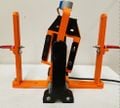






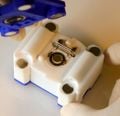

![Flypi - Dispositivo portátil para experimentos de microscopia, termo e optogenética [1]](/w/images/thumb/4/4a/Flypi.png/109px-Flypi.png)

